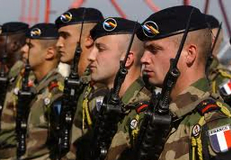In its largest military expansion since the end of the Cold War, NATO members have confirmed the creation of a brand new rapid reaction force in 2015. This new force is the culmination of months of efforts on the part of NATO countries to bolster their response to Russian military actions in Ukraine, and gives the organization increased deterrence capacity and credibility. And while NATO members are carefully avoiding rhetoric that suggests a “new” Cold War is brewing, increased militarization on both sides is giving this notion some credence.
In September 2014, we talked about how one of the main commitments to come out of the highest-level NATO meeting in recent memory was the approval of a rapid reaction force for the organization. As the perceived threat from the East (read: Russia) continues unabated, NATO needed to “ensure the Alliance is ready to respond swiftly and firmly to new security challenges.” The new rapid reaction force – the “biggest reinforcement” of NATO’s collective defence since the end of the Cold War – symbolizes the evolving nature of geopolitical relations on the European continent, and represents a significant financial and logistical commitment for the member nations, so much so that the force approved for 2015 will only be temporary, with a more permanent force scheduled to be in place by 2016.
Initially, the rapid reaction force discussed at the September meeting was supposed to be lead by the British. The final plans for the interim rapid reaction force announced this week will be a land-based, brigade-size force of approximately 4,000 troops, with contributions from Germany, Norway and the Netherlands. The current plans are to rotate the responsibility for the force across member nations in the short term, while the medium term plan is to finance a permanent “spearhead” by early 2016, which would be comprised “of several thousand ground troops supported by air, maritime and special forces, able to deploy within a few days.”
NATO leadership is making no qualms about the reason behind this aggressive expansion of military capacity. In remarks earlier this week, NATO Secretary General Jens Stoltenberg said “What we are doing is in response to Russia.” And, indeed, Russian actions in Ukraine have raised alarm bells all across the continent, and in particular in Eastern Europe, where NATO members such as Poland and the Baltic states are legitimately fearing Russian incursions into their territory, and counting on NATO to be able to respond swiftly and decisively should this occur. The new rapid reaction force is primarily meant to be act as a deterrent – the hope is that its mere existence will shift the risk analysis for Russia, making it less likely to attempt military actions along its western borders.
Ukraine not being a part NATO means that there is little the organization itself can do to protect Ukrainian sovereignty and territorial integrity, though member states are not prevented from assisting Ukraine on a bilateral basis. And while aid funding has been made available – the US has already provided $118 million in assistance and training to the Ukrainian government – no member state, including the US, has been providing lethal weaponry to the country.
Meanwhile, diplomats are working to get the Russia-NATO Council back on track, to be able to resume formal discussions through official channels. NATO’s new military expansion, though, may make it more difficult for cooperation to begin anew between Russia and NATO members. While the primary function of the new rapid reaction force is to act as deterrent, as the door remains “open” for new members to join – including Ukraine and Georgia, which have been directly targeted by Russia in recent years – the potential for increased confrontation between NATO members and Russia increases.
